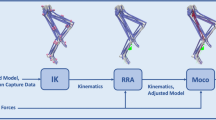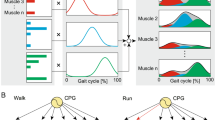Abstract
Existing “off-the-shelf” musculoskeletal models are problematic when simulating movements that involve substantial hip and knee flexion, such as the upstroke of pedalling, because they tend to generate excessive passive fibre force. The goal of this study was to develop a refined musculoskeletal model capable of simulating pedalling and fast running, in addition to walking, which predicts the activation patterns of muscles better than existing models. Specifically, we tested whether the anomalous co-activation of antagonist muscles, commonly observed in simulations, could be resolved if the passive forces generated by the underlying model were diminished. We refined the OpenSim™ model published by Rajagopal et al. (IEEE Trans Biomed Eng 63:1–1, 2016) by increasing the model’s range of knee flexion, updating the paths of the knee muscles, and modifying the force-generating properties of eleven muscles. Simulations of pedalling, running and walking based on this model reproduced measured EMG activity better than simulations based on the existing model—even when both models tracked the same subject-specific kinematics. Improvements in the predicted activations were associated with decreases in the net passive moments; for example, the net passive knee moment during the upstroke of pedalling decreased from 36.9 N m (existing model) to 6.3 N m (refined model), resulting in a dramatic decrease in the co-activation of knee flexors. The refined model is available from SimTK.org and is suitable for analysing movements with up to 120° of hip flexion and 140° of knee flexion.








Similar content being viewed by others
References
Arnold, E. M., S. R. Hamner, A. Seth, M. Millard, and S. L. Delp. How muscle fiber lengths and velocities affect muscle force generation as humans walk and run at different speeds. J. Exp. Biol. 216:2150–2160, 2013.
Arnold, E. M., S. R. Ward, R. L. Lieber, and S. L. Delp. A model of the lower limb for analysis of human movement. Ann. Biomed. Eng. 38:269–279, 2010.
Blemker, S. S., and S. L. Delp. Rectus femoris and vastus intermedius fiber excursions predicted by three-dimensional muscle models. J. Biomech. 39:1383–1391, 2006.
Buford, W. L., F. M. Ivey, J. D. Malone, R. M. Patterson, G. L. Peare, D. K. Nguyen, and A. A. Stewart. Muscle balance at the knee-moment arms for the normal knee and the ACL-minus knee. IEEE Trans. Rehabil. Eng. 5:367–379, 1997.
Chen, X., G. N. Sanchez, M. J. Schnitzer, and S. L. Delp. Changes in sarcomere lengths of the human vastus lateralis muscle with knee flexion measured using in vivo microendoscopy. J. Biomech. 49:2989–2994, 2016.
Delp, S. L., F. C. Anderson, A. S. Arnold, P. Loan, A. Habib, C. T. John, E. Guendelman, and D. Thelen. OpenSim: open-source software to create and analyze dynamic simulations of movement. IEEE Trans. Biomed. Eng. 54:1940–1950, 2007.
Delp, S. L., J. P. Loan, M. G. Hoy, F. E. Zajac, E. L. Topp, and J. M. Rosen. An interactive graphics-based model of the lower extremity to study orthopaedic surgical procedures. IEEE Trans. Biomed. Eng. 37:757–767, 1990.
Dick, T. J. M., A. S. Arnold, and J. M. Wakeling. Quantifying Achilles tendon force in vivo from ultrasound images. J. Biomech. 49:3200–3207, 2016.
Dick, T. J., A. A. Biewener, and J. M. Wakeling. Comparison of human gastrocnemius forces predicted by Hill-type muscle models and estimated from ultrasound images. J. Exp. Biol. 220:778–782, 2017.
Eng, C. M., A. S. Arnold, D. E. Lieberman, and A. A. Biewener. The capacity of the human iliotibial band to store elastic energy during running. J. Biomech. 48:3341–3348, 2015.
Fregly, B. J., T. F. Besier, D. G. Lloyd, S. L. Delp, S. A. Banks, M. G. Pandy, and D. D. D’Lima. Grand challenge competition to predict in vivo knee loads. J. Orthop. Res. 30:503–513, 2012.
Friederich, J. A., and R. A. Brand. Muscle fiber architecture in the human lower limb. J. Biomech. 23:91–95, 1990.
Guan, S., H. A. Gray, F. Keynejad, and M. G. Pandy. Mobile biplane x-ray imaging system for measuring 3D dynamic joint motion during overground gait. IEEE Trans. Med. Imaging 35:326–336, 2016.
Hamner, S. R., and S. L. Delp. Muscle contributions to fore-aft and vertical body mass center accelerations over a range of running speeds. J. Biomech. 46:780–787, 2013.
Handsfield, G. G., C. H. Meyer, J. M. Hart, M. F. Abel, and S. S. Blemker. Relationships of 35 lower limb muscles to height and body mass quantified using MRI. J. Biomech. 47:631–638, 2014.
Hicks, J. L., T. K. Uchida, A. Seth, A. Rajagopal, and S. L. Delp. Is my model good enough? Best practices for verification and validation of musculoskeletal models and simulations of movement. J. Biomech. Eng. 137:1–24, 2015.
Hirata, K., H. Kanehisa, E. Miyamoto-Mikami, and N. Miyamoto. Evidence for intermuscle difference in slack angle in human triceps surae. J. Biomech. 48:1210–1213, 2015.
Lai, A., G. A. Lichtwark, A. G. Schache, Y.-C. Lin, N. A. T. Brown, and M. G. Pandy. In vivo behavior of the human soleus muscle with increasing walking and running speeds. J. Appl. Physiol. 118:1266–1275, 2015.
Lai, A., A. G. Schache, N. A. T. Brown, and M. G. Pandy. Human ankle plantar flexor muscle–tendon mechanics and energetics during maximum acceleration sprinting. J. R. Soc. Interface 13:20160391, 2016.
Lichtwark, G. A., K. Bougoulias, and A. M. Wilson. Muscle fascicle and series elastic element length changes along the length of the human gastrocnemius during walking and running. J. Biomech. 40:157–164, 2007.
Lieber, R. L., G. J. Loren, and J. Fridén. In vivo measurement of human wrist extensor muscle sarcomere length changes. J. Neurophysiol. 71:874–881, 1994.
Liu, M. Q., F. C. Anderson, M. H. Schwartz, and S. L. Delp. Muscle contributions to support and progression over a range of walking speeds. J. Biomech. 41:3243–3252, 2008.
Millard, M., T. Uchida, A. Seth, and S. L. Delp. Flexing computational muscle: modeling and simulation of musculotendon dynamics. J. Biomech. Eng. 135:1–11, 2013.
Perry, J., and J. M. Burnfield. Gait analysis: normal and pathological function. New Jersey: Slack Incorporated, pp. 1–551, 2010.
Rajagopal, A., C. Dembia, M. DeMers, D. Delp, J. Hicks, and S. Delp. Full body musculoskeletal model for muscle-driven simulation of human gait. IEEE Trans. Biomed. Eng. 63:1–1, 2016.
Riener, R., and T. Edrich. Identification of passive elastic joint moments in the lower extremities. J. Biomech. 32:539–544, 1999.
Thelen, D. G., and F. C. Anderson. Using computed muscle control to generate forward dynamic simulations of human walking from experimental data. J. Biomech. 39:1107–1115, 2006.
Von Tscharner, V. Intensity analysis in time-frequency space of surface myoelectric signals by wavelets of specified resolution. J. Electromyogr. Kinesiol. 10:433–445, 2000.
Wakeling, J. M., and T. Horn. Neuromechanics of muscle synergies during cycling. J. Neurophysiol. 101:843–854, 2009.
Walker, P. S., J. S. Rovick, and D. D. Robertson. The effects of knee brace hinge design and placement on joint mechanics. J. Biomech. 21:965969–967974, 1988.
Ward, S., C. Eng, L. Smallwood, and R. Lieber. Are current measurements of lower extremity muscle architecture accurate? Clin. Orthop. Relat. Res. 467:1074–1082, 2009.
Whittington, B., A. Silder, B. Heiderscheit, and D. G. Thelen. The contribution of passive-elastic mechanisms to lower extremity joint kinetics during human walking. Gait Posture 27:628–634, 2008.
Wickiewicz, T. L., R. R. Roy, P. L. Powell, J. J. Perrine, and V. R. Edgerton. Muscle architecture and force-velocity relationships in humans. J. Appl. Physiol. 57:435–443, 1984.
Zajac, F. E. Muscle and tendon: properties, models, scaling, and application to biomechanics and motor control. Crit. Rev. Biomed. Eng. 17:359–411, 1989.
Zhang, J., and T. F. Besier. Accuracy of femur reconstruction from sparse geometric data using a statistical shape model. Comput. Methods Biomech. Biomed. Eng. 20:566–576, 2017.
Acknowledgments
We thank Taylor Dick, Sidney Morrison and Glen Lichtwark for their assistance in collecting and post-processing the experimental data used in this study, and we are grateful to Andy Biewener and Carolyn Eng for helpful discussions. Funding for this work was provided by the National Institutes of Health Grant 2R01AR055648.
Author information
Authors and Affiliations
Corresponding author
Additional information
Associate Editor Estefanía Peña oversaw the review of this article.
Electronic supplementary material
Below is the link to the electronic supplementary material. Supplementary Figure S1 Knee moment arms of MTUs as predicted by Rajagopal et al.’s model25 and by our intermediate model after updating the tibiofemoral translations and MTU paths. The MTUs include vastus lateralis (VL), vastus medialis (VM), vastus intermedius (VI), rectus femoris (RF), semimembranosus (SM), semitendinosus (ST), biceps femoris long head (BFLH), biceps femoris short head (BFSH), medial gastrocnemius (MG), lateral gastrocnemius (LG), sartorius (SA) and gracilis (GR). Moment arms predicted by the models are compared with measured moment arms reported by Buford et al.4 from tendon excursion experiments. Note that the moment arms for Rajagopal et al.’s model are extrapolated for knee angles greater than 120° (lighter dotted lines). Supplementary Figure S2 Net total moments (dotted lines) and net passive and active moments (shaded regions) generated by MTUs crossing the hip, knee, and ankle as estimated from muscle-driven simulations of pedalling (left), walking (middle), and running (right). Net moments estimated using our refined model are compared to the moments estimated using our intermediate model.
Rights and permissions
About this article
Cite this article
Lai, A.K.M., Arnold, A.S. & Wakeling, J.M. Why are Antagonist Muscles Co-activated in My Simulation? A Musculoskeletal Model for Analysing Human Locomotor Tasks. Ann Biomed Eng 45, 2762–2774 (2017). https://doi.org/10.1007/s10439-017-1920-7
Received:
Accepted:
Published:
Issue Date:
DOI: https://doi.org/10.1007/s10439-017-1920-7




